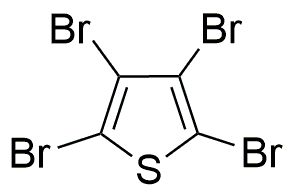Tetrabromothiophene is widely utilized in research focused on:
- Flame Retardants: Its bromine content makes it an effective flame retardant in various materials, particularly in plastics and textiles, enhancing safety in consumer products.
- Conductive Polymers: This compound is used in the development of conductive polymers, which are essential in electronics for applications like flexible displays and sensors.
- Organic Photovoltaics: Tetrabromothiophene serves as a building block in organic solar cells, improving efficiency and stability in renewable energy technologies.
- Biological Research: It is employed in studies related to environmental science, particularly in assessing the effects of brominated compounds on aquatic ecosystems.
- Antimicrobial Agents: The compound has potential applications in developing antimicrobial agents, providing a solution for combating resistant bacterial strains.
General Information
Properties
Safety and Regulations
Applications
Tetrabromothiophene is widely utilized in research focused on:
- Flame Retardants: Its bromine content makes it an effective flame retardant in various materials, particularly in plastics and textiles, enhancing safety in consumer products.
- Conductive Polymers: This compound is used in the development of conductive polymers, which are essential in electronics for applications like flexible displays and sensors.
- Organic Photovoltaics: Tetrabromothiophene serves as a building block in organic solar cells, improving efficiency and stability in renewable energy technologies.
- Biological Research: It is employed in studies related to environmental science, particularly in assessing the effects of brominated compounds on aquatic ecosystems.
- Antimicrobial Agents: The compound has potential applications in developing antimicrobial agents, providing a solution for combating resistant bacterial strains.
Documents
Safety Data Sheets (SDS)
The SDS provides comprehensive safety information on handling, storage, and disposal of the product.
Product Specification (PS)
The PS provides a comprehensive breakdown of the product’s properties, including chemical composition, physical state, purity, and storage requirements. It also details acceptable quality ranges and the product's intended applications.
Certificates of Analysis (COA)
Search for Certificates of Analysis (COA) by entering the products Lot Number. Lot and Batch Numbers can be found on a product’s label following the words ‘Lot’ or ‘Batch’.
*Catalog Number
*Lot Number
Certificates Of Origin (COO)
This COO confirms the country where the product was manufactured, and also details the materials and components used in it and whether it is derived from natural, synthetic, or other specific sources. This certificate may be required for customs, trade, and regulatory compliance.
*Catalog Number
*Lot Number
Safety Data Sheets (SDS)
The SDS provides comprehensive safety information on handling, storage, and disposal of the product.
DownloadProduct Specification (PS)
The PS provides a comprehensive breakdown of the product’s properties, including chemical composition, physical state, purity, and storage requirements. It also details acceptable quality ranges and the product's intended applications.
DownloadCertificates of Analysis (COA)
Search for Certificates of Analysis (COA) by entering the products Lot Number. Lot and Batch Numbers can be found on a product’s label following the words ‘Lot’ or ‘Batch’.
*Catalog Number
*Lot Number
Certificates Of Origin (COO)
This COO confirms the country where the product was manufactured, and also details the materials and components used in it and whether it is derived from natural, synthetic, or other specific sources. This certificate may be required for customs, trade, and regulatory compliance.


